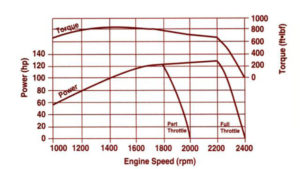Description
Understanding tractor power and pulling capacity is essential when selecting appropriate equipment for an operation. A general explanation of how a tractor utilizes engine horsepower and torque is outlined in this section.
Manufacturers specify the power output of their tractors and the ratings are usually certified by an independent laboratory. Tractors manufactured in the United States are tested at the Nebraska Tractor Test Laboratory. The tests results are online and provide information on maximum horsepower, pulling capacities at different speeds, and fuel efficiencies.
Application
Horsepower is the rate of doing work. Work is moving a weight over a distance. Early power measurements were derived by a horse moving a weight over a distance in a given time, thus horsepower. It was defined as 33,000 foot-pounds per minute. Torque is the force that causes a twisting effort in a rotating shaft such as a tractor axle and wheels or a power-take-off (PTO) shaft. PTO horsepower is determined by the amount of torque in foot-pounds of force (ft-lbf) and shaft speed in revolutions per minute (rpm). The term “power,” a more universally accepted term today, is used in the remaining discussion rather than horsepower. Key terms used in describing tractor operation are in italics.
Each tractor model has a rated power that has been measured at the rated engine speed. Engine and governor design determine the rated engine speed. The rated power is the power that the engine will develop at the rated speed, with a fully open throttle. When the engine is producing the rated power at the rated speed, the governor will be fully open and providing maximum fuel flow to the engine. For most tractors, the rated power is also the maximum power. However, some newer tractors have a maximum power that is greater than the rated power. Electronic governors and new engine designs allow the power to increase as the engine speed drops below the rated speed.
Tractor engine power can be used in several ways. The most common uses are the PTO shaft and the drawbar. PTO power is easy to accurately measure, and is the most common way of describing tractor power. PTO power is about 96 to 98 percent of engine power.
Drawbar power is power available to pull an implement. This power is transmitted through the axles and wheels to the soil. Drawbar power is highly variable and depends on the traction between the wheels and the soil surface. Drawbar power is often 50 to 75 percent of PTO power. Draft force is the force needed to pull an implement.
Figure 1 shows the power and torque curves as a function of engine speed for a typical tractor engine. The maximum engine power is developed at the rated speed of 2200 rpm. High-idle speed of 2400 rpm is the engine speed at full throttle with the transmission in park. As a load is applied to the engine (tractor plowing), engine speed decreases and the governor continues to open until it is fully open at 2200 rpm. At this point the engine is developing maximum power (maximum acres per hour). Governor action of 200 rpm is common. Increasing the load reduces the engine speed and power. Torque, however, is increasing as speed is decreasing until 1400 rpm. This increase in torque is called torque rise. The torque rise is what provides a tractor’s lugging ability; the ability to increase drawbar pull to overcome hard spots in a field without stopping. Lugging the engine is acceptable if it is not too severe or occurs too frequently. If tractor engine overheating occurs, a lower gear should be used.

Figure 1. Power and torque interact to modify power output at part and full throttle.

